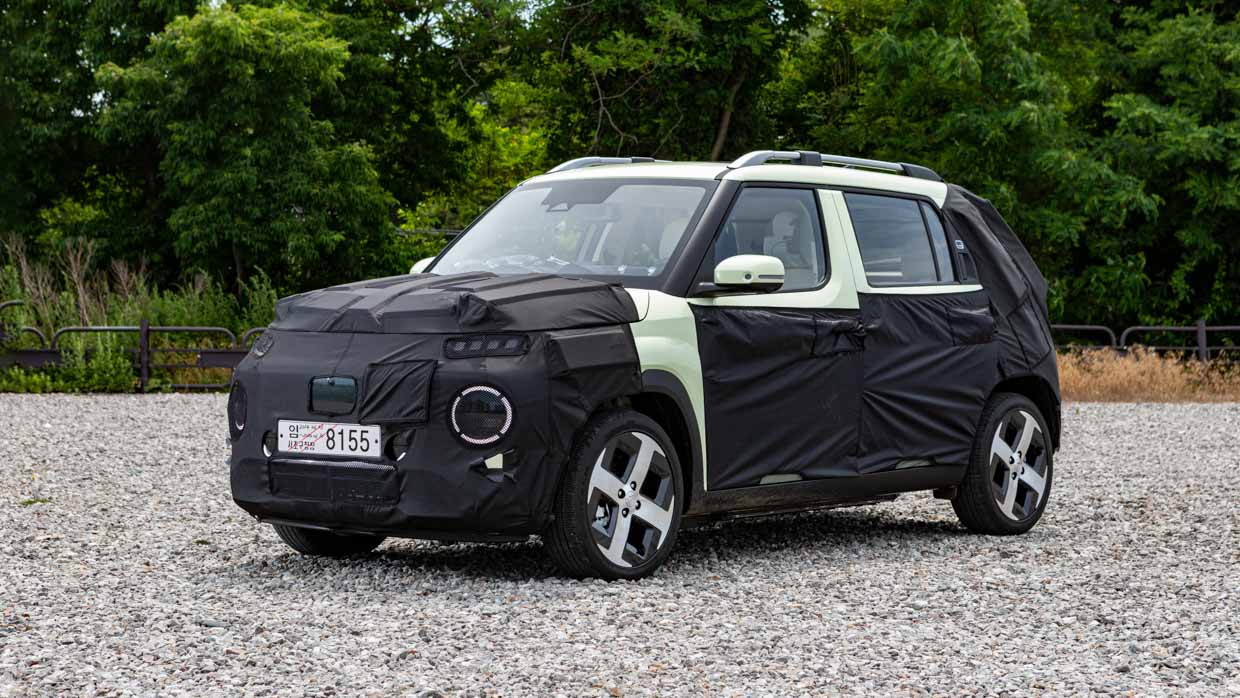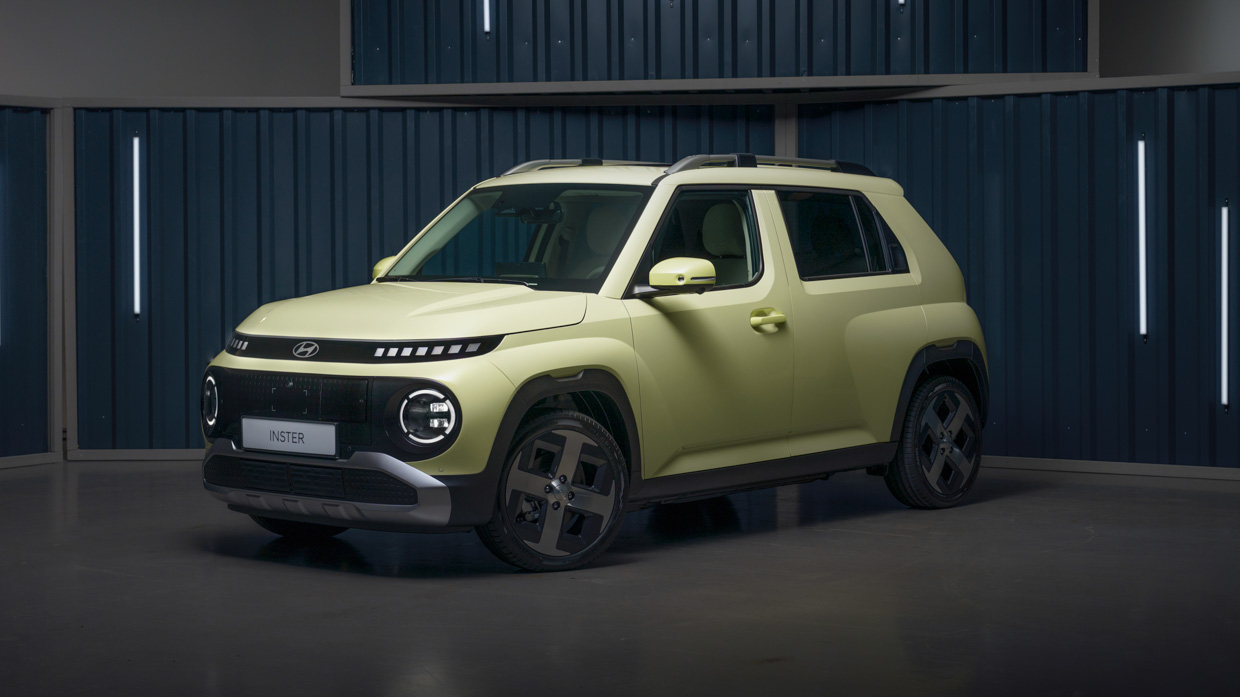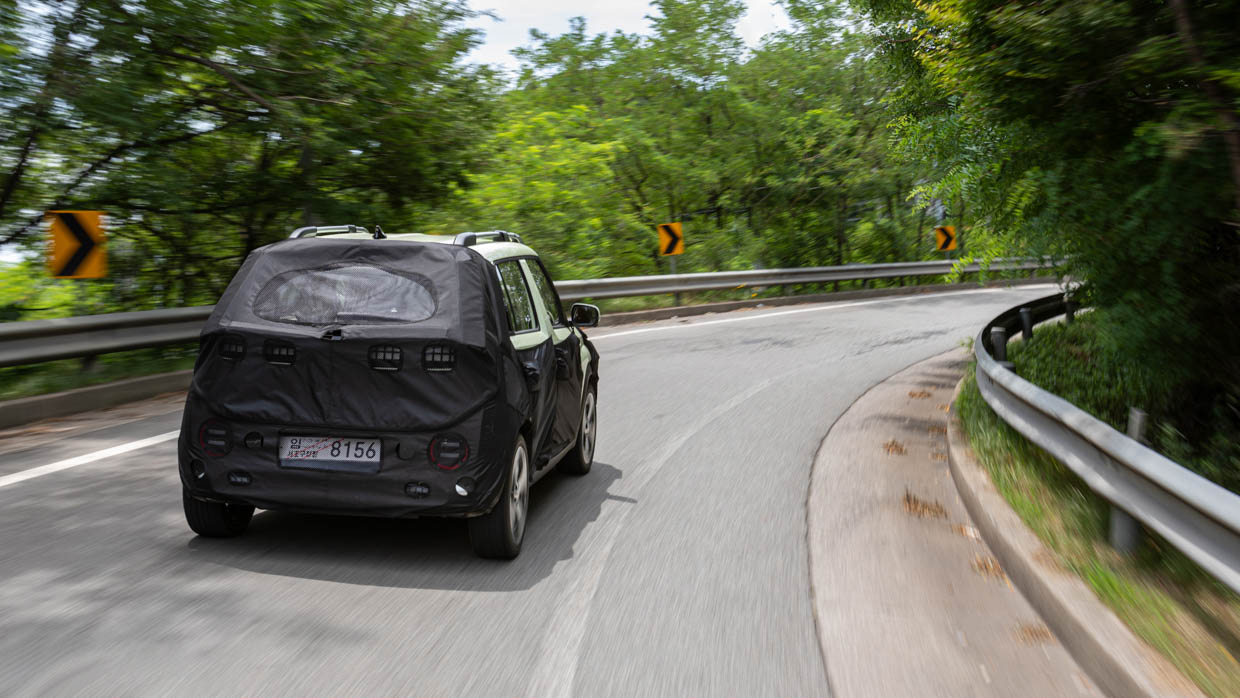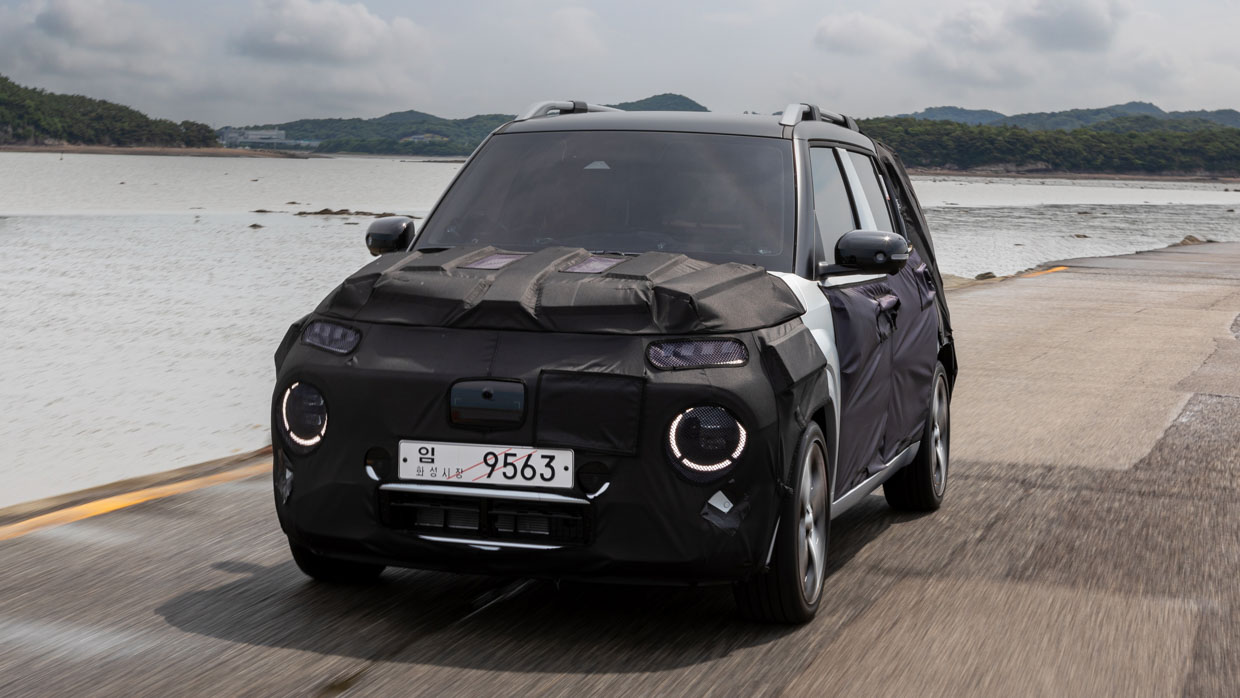-
Car Reviews
- All reviews
- Midsize SUVs
- Small cars
- Utes
- Small SUVs
- Large SUVs
- Large cars
- Sports SUVs
- Sports cars
- Vans
Latest reviews
- Car News
-
Car Comparisons
Latest comparisons
- Chasing Deals
The Hyundai Inster promises to shake up the affordable end of the electric car market – should BYD and MG be worried?
The Hyundai Inster is on its way to shake things up.
Currently, if you’re in the market for a small electric car and want to spend around $40,000 or less, your options will be limited to the likes of the BYD Dolphin, GWM Ora, or MG4.

The fact that there is choice is a good thing, but note the lack of options from non-Chinese legacy carmakers who have struggled to match rapid Chinese expansion in the affordable EV space.
At present, the entry-point into electric vehicle ownership in the Hyundai range is $54,000 before on-road costs for the entry-level Kona.
But that’s all set to change in early 2025 when the Korean marque’s Inster small electric SUV lands in Australia.

Revealed in full at the Busan Mobility Show in June, the Inster is based on the Korean-only petrol-powered Hyundai Casper small SUV that’s been on sale since 2021 and which shares a platform with the Kia Picanto small car.
To be called the Casper EV back home in Korea, the Inster – as it will be known outside its home market – has been re-worked for electrification with an extended body and longer wheelbase as compared to its ICE counterpart, which we won’t get in Australia.
To be available with two powertrain options, the affectionately styled EV will promise up to 355km of WLTP driving range and a compelling price tag expected to be in the vicinity of $40,000, and which could potentially begin with a three.

Hyundai has proven itself a formidable manufacturer of well-regarded EVs, so could this affordably priced electric city car be the EV gamechanger we’ve been waiting for?
We were amongst the first media in the world to get to drive one of the final pre-production prototypes in Korea to get a taste of what we can expect.
Pricing and specifications for Australian market Insters have not yet been confirmed, but some initial details have already firmed up.
The Inster will launch in either standard- or long-range guise, with the standard variant using a 42kWh battery and the long-range featuring a 49kWh battery.

Powering the Inster will be a 71kW electric motor in the base variant and a more powerful 84kW in the higher spec, both of which have 147Nm of torque.
Both variants will be front-wheel drive and it’s expected the Inster will take a similar approach to the larger Hyundai Kona, which also offers two powertrain options and two trim-grades.
Projected WLTP range is said to exceed 300km for the standard range, with a target of 355km for the long-range when specified with 15-inch wheels.

These aren’t massive figures, but viewed in context of its most likely use case as a small daily runabout city-car, or second car, they are acceptable.
Hyundai also says that a more rugged outdoor-focussed Inster Cross variant will eventually make its way Down Under, but timings and details on that are yet to be confirmed.
Featuring endearingly characterful styling across all variants, you’ll be paying for a 3815mm -long footprint dimensionally speaking, with a 2580mm wheelbase, 1610mm of width and 1575mm of height.

Thus, the Inster is a shorter vehicle than Hyundai’s current smallest vehicle in Australia, the Venue small SUV. However, the Inster’s wheelbase is longer and not far off that of its bigger Kona sibling, which does bring interior packaging benefits as we’ll cover off below.
While Australian specifications have not yet been confirmed, the Inster will be available with features including:
Our Korean drive loop with one of the final camouflaged pre-production Insters was short and entirely on urban roads at speeds of up to 80km/h. This is not enough to deliver a full assessment of the vehicle, though enough to get a taste and share some initial impressions.
The overall feeling the Inster excluded was of a pleasant ease-of-use, which makes sense given we were also driving it in its natural environment of urban areas and at city speeds.

The steering feels quite light and direct and makes for a car that was easy to place on the road, helped by solid outward visibility.
At times, the ride felt a tad crashy over urban imperfections and particularly bad bumps, however we were driving on the lower-profile 17-inch wheels so I’m not sure how much of an impact that made. We will reserve judgement on that until we can drive the Intser on local roads in local specs.
As for handling, the Inster felt more than capable around urban areas, unsurprisingly, however we weren’t able to fully exploit any windier roads at higher speeds to get a better sense of whether it was a keen handler or not.

Power delivery felt natural and progressive but at the same time, you won’t be setting any land speed records. Acceleration to 100km/h from a standstill takes at least 10 seconds claimed, though as an urban runabout by the seat of the pants it feels quite adequate.
The brake pedal also felt natural and easy to modulate, and like with other Hyundais you can use the paddles on the steering wheel to switch between different levels of regenerative braking, including a maximum regen i-Pedal mode if you prefer more of a one-pedal driving experience.
You can also switch between different drive modes – eco, normal, sport and snow – very easily using a switch on the steering wheel, however our drive wasn’t long enough to experiment with the different modes in great depth.

Driving at slightly higher speeds – up to 80km/h – and the Inster felt solidly planted and delivered a reasonably quiet drive experience in the scenarios which we experienced.
Ultimately, a more rigorous test at higher speeds in Australian-spec vehicles on bumpy local roads will be required over a longer time to form a firm judgement, but at least on initial impression, the Inster seems like a competent and pleasant enough daily runabout.
Certainly, a compelling part of the Inster’s proposition is the fact that it’s a small vehicle that doesn’t feel that diminutive inside.
While it is smaller than something like a Kona, it doesn’t feel tight and there’s a decent amount of airiness to the cabin, which was no doubt helped by the light colour scheme of our test vehicle.

However, there are also smart packaging solutions that add to the open feeling including the fact that our test vehicle had front bench seats that meant there was no transmission tunnel or centre console. Because of this, drivers and passengers can easily slide to the opposite door to exit the vehicle if in a particularly tight spot, for example.
The bench-style seat included two cup holders integrated into the middle between the driver and passenger, along with a fold-down centre armrest – it would be nice if that was a bit wider so that the driver and front passenger could easily share it.
Elsewhere, the cabin has many familiar Hyundai touches including the four-dot emblem steering wheel and a shift-by-wire column mounted shifter, which also helps free up space from usual centre-console positioning.

Unlike more expensive variants, the dual digital instrument and infotainment screens are not a single conjoined piece, but positioned separately. Either way, the graphics were clear and simple and easy-to-use, though our test vehicle had a few occasional glitches, owing to the fact that it was still a pre-production variant.
What will no doubt be pleasing to many drivers is the fact that the functional cabin retains a plethora of physical buttons and controls, so there’s an instant old-school familiarity in that regard.
There are both USB-A and USB-C connections, a useful open storage area above the glovebox, and interesting features like customisable door inserts which apparently you’ll be able to get in different colours – jury is still out on that one!

Visibility seems good all-round, however on the negative front there do seem to be quite a lot of hard plastics around the cabin, which is to be expected to some degree given where the vehicle’s positioned and where it’s expected to be priced.
Moving into the rear of the four-seat Inster I found the seats to be quite comfortable and supportive.
At 183cm there was decent head, leg and toe room, which was pleasing and no doubt helped by the longer wheelbase of the EV. Perhaps a touch more under thigh support would have been welcomed.


Adding to the practicality of the vehicle is the fact that the rear seats split 50/50 and both slide and recline, which can help increase boot space from a minimum 280 litres to a maximum 351 litres.
Given its petite portions and value-focused proposition, the Inster isn’t packed with rear seat amenities.
There were no rear air vents, map pockets, cup-holders, or centre armrest and USB-C connections in the vehicle we were in, so as a vehicle that’s constantly ferrying four people it might start to lose a few points there, but as a daily runabout that only occasionally operates at capacity, it’s certainly a pleasing and accommodating interior package.
The Hyundai Inster has not yet been crash-tested by ANCAP, however Hyundai has confirmed an extensive list of active and safety features available for the vehicle globally including:
Service intervals and pricing will be confirmed closer to the local Australian launch for the Inster.
As for warranty, Hyundai offers a five-year, unlimited-kilometre warranty for its models in Australia.

In terms of efficiency, the claimed WLTP consumption for the Inster is 15.3kWh/100km on 15-inch wheels.
We look forward to conducting a full range and efficiency test on Australian spec vehicles when we can get one into the Chasing Cars garage next year.
While it will be the brand’s smallest and most affordable electric vehicle, my initial impressions of the Inster are of a promising electric urban runabout.
Final judgement will be reserved until we can drive it on Aussie roads, and expectedly – provided the vehicle continues to drive well on local roads – a big part of the final verdict will be pricing.

If Hyundai can deliver a knockout blow when it comes to the entry-price then that will certainly intensify competition in the electric market, which would ultimately benefit everyone.
On early evidence, yes, BYD and MG should be worried.
For now, we’re excited to see a new affordable small EV join the Australian market. With such a plethora of large cars, utes and SUVs on our roads, and seemingly more and more small cars being axed every year, it’s refreshing to see Hyundai’s take on the small SUV genre, a vehicle segment where electric vehicles make arguably the most sense.
About Chasing cars
Chasing Cars reviews are 100% independent.
Because we are powered by Budget Direct Insurance, we don’t receive advertising or sales revenue from car manufacturers.
We’re truly independent – giving you Australia’s best car reviews.
The estimate provided does not take into account your personal circumstances but is intended to give a general indication of the cost of insurance, in order to obtain a complete quote, please visit www.budgetdirect.com.au. Estimate includes 15%^ online discount.
^Conditions Apply
Budget Direct Insurance arranged by Auto & General Services Pty Ltd ACN 003 617 909(AGS) AFSL 241 411, for and on behalf of the insurer, Auto & General Insurance Company Limited(ABN 42 111 586 353, AFSL 285 571).Because we don’t know your financial needs, we can’t advise you if this insurance will suit you. You should consider your needs and the Product Disclosure Statement before making a decision to buy insurance. Terms and conditions apply.
Indicative quote based on assumptions including postcode , 40 year old male with no offences, licence suspensions or claims in the last 5 years, a NCD Rating 1 and no younger drivers listed. White car, driven up to 10,000kms a year, unfinanced, with no modifications, factory options and/or non-standard accessories, private use only and garaged at night.
^Online Discounts Terms & Conditions
1. Discounts apply to the premium paid for a new Budget Direct Gold Comprehensive Car Insurance, Third Party Property Only or Third Party Property, Fire & Theft Insurance policy initiated online on or after 29 March 2017. Discounts do not apply to optional Roadside Assistance.
2. Discounts do not apply to any renewal offer of insurance.
3. Discounts only apply to the insurance portion of the premium. Discounts are applied before government charges, taxes, levies and fees, including instalment processing fees (as applicable). The full extent of discounts may therefore be impacted.
4. We reserve the right to change the offer without notice.